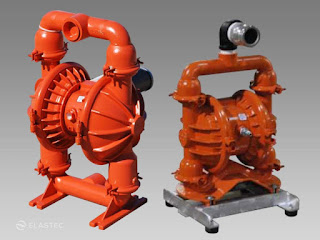· Peristaltic Pump:
A peristaltic pump is a sort of positive relocation pump utilized for pumping an assortment of liquids, they are likewise regularly known as roller pumps. The liquid is contained inside an adaptable cylinder fitted inside a round pump packaging (however straight peristaltic pumps have been made). A rotor with a number of "rollers", "shoes", "wipers", or "lobes" attached to the external circumference of the rotor compresses the flexible tube. As the rotor turns, the part of the tube under compression is pinched closed (or "occludes") thus forcing the fluid to be pumped to move through the tube. Additionally, as the tube opens to its natural state after the passing of the cam ("restitution" or "resilience") fluid flow is induced to the pump. This process is called peristalsis and is used in many biological systems such as the gastrointestinal tract. Ordinarily, there will be at least two rollers, or wipers, impeding the cylinder, catching between them a collection of liquid. The assortment of liquid is then transported, at the surrounding weight, at the pump outlet. Peristaltic pumps may run constantly, or they might be ordered through fractional transformations to convey littler measures of liquid.
· Diaphragm Pump:
Ordinarily, there will be at least two rollers, or wipers, impeding the cylinder, catching between them a collection of liquid. The assortment of liquid is then transported, at the surrounding weight, at the pump outlet. Peristaltic pumps may run constantly, or they might be ordered through fractional transformations to convey littler measures of liquid.
There are three main types of diaphragm pumps:
Those in which the diaphragm is sealed with one side in the fluid to be pumped, and the other in the air or hydraulic fluid. The diaphragm is flexed, causing the volume of the pump chamber to increase and decrease. A pair of non-return check valves prevents the reverse flow of the fluid.[1]
Those employing volumetric positive displacement where the prime mover of the diaphragm is electro-mechanical, working through a crank or geared motor drive, or purely mechanical, such as with a lever or handle. This method flexes the diaphragm through simple mechanical action, and one side of the diaphragm is open to air.[2]
Those employing one or more unsealed diaphragms with the fluid to be pumped on both sides. The diaphragm(s) again are flexed, causing the volume to change.
At the point when the volume of a chamber of either kind of pump is expanded (the stomach climbing), the weight diminishes, and liquid is drawn into the chamber. At the point when the chamber weight later increments from diminished volume (the stomach moving down), the liquid recently attracted is constrained out. Finally, the diaphragm moving up once again draws fluid into the chamber, completing the cycle. This action is similar to that of the cylinder in an internal combustion engine. Diaphragm Pumps deliver a hermetic seal between the drive mechanism and the compression chamber, allowing the pump to transfer, compress, and evacuate the medium without a lubricant.
· Positive Displacement Pump:
A positive displacement pump makes a fluid move by trapping a fixed amount and forcing (displacing) that trapped volume into the discharge pipe.
Some positive displacement pumps utilize a growing hole on the suction side and a diminishing pit on the release side. Fluid streams into the pump as the depression on the suction side grows and the fluid streams out of the release as the pit breakdown. The volume is steady through each cycle of activity.
To know more about AODD manufacturer
· Hydraulic Pump:
Pressure-driven pumps are utilized in water powered drive frameworks and can be hydrostatic or hydrodynamic. A water driven pump is a mechanical wellspring of intensity that changes over mechanical power into pressure driven vitality (hydrostatic vitality i.e. stream, weight). It generates flow with enough power to overcome pressure induced by the load at the pump outlet. When a hydraulic pump operates, it creates a vacuum at the pump inlet, which forces liquid from the reservoir into the inlet line to the pump and by mechanical action delivers this liquid to the pump outlet and forces it into the hydraulic system. Hydrostatic pumps are positive displacement pumps while hydrodynamic pumps can be fixed displacement pumps, in which the displacement (flow through the pump per rotation of the pump) cannot be adjusted, or variable displacement pumps, which have a more complicated construction that allows the displacement to be adjusted. Hydrodynamic pumps are more frequent in day-to-day life. Hydrostatic pumps of various types all work on the principle of Pascal's law.
Click here to know more about diaphragm pump working

Comments
Post a Comment